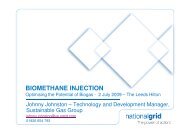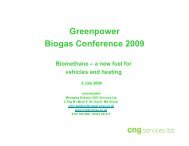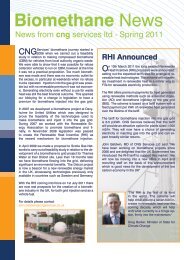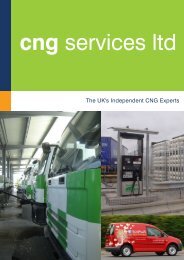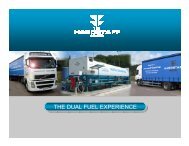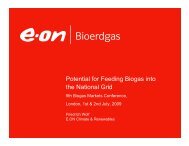Bio-SNG - CNG Services
Bio-SNG - CNG Services
Bio-SNG - CNG Services
Create successful ePaper yourself
Turn your PDF publications into a flip-book with our unique Google optimized e-Paper software.
BIO-<strong>SNG</strong> FEASIBILITY STUDY – ESTABLISHMENT OF A REGIONAL PROJECT“ICF” means the Incomplete Combustion Factor;“mg/m3” means milligrams per cubic metre at 15C and 1.01325 bar;“MJ/m3” means megajoules per cubic metre where the calorific value of a dry gas is determined on thebasis that the water produced by combustion is assumed to be condensed;“N2” means the percentage by volume of nitrogen in the equivalent mixture;“PN” means the sum of the percentages by volume of propane and nitrogen in the equivalent mixture;“relative density” means the ratio of the mass of a volume of the gas when containing no water vapour tothe mass (expressed in the same units) of the same volume of air containing no water vapour under thesame conditions of temperature and pressure;“SI” means the Soot Index;“WN” means the Wobbe Number;trigonometric functions are to be evaluated in radians.190 The Wobbe Number of gases should be determined on the basis that any water vapour in the gashas first been removed.2 In this Schedule, ICF, SI and WN shall be calculated in accordance with the following formulae –ICF = WN-50.73+0.03PN 1.56SI = 0.896 tan-1 (0.0255C3H8 - 0.0233N2 + 0.617)WN = calorific value“relative density” means the ratio of the mass of a volume of the gas when containing no water vapour tothe mass (expressed in the same units) of the same volume of air containing no water vapour under thesame conditions of temperature and pressure;“SI” means the Soot Index;“WN” means the Wobbe Number;trigonometric functions are to be evaluated in radians.190 The Wobbe Number of gases should be determined on the basis that any water vapour in the gashas first been removed.2 In this Schedule, ICF, SI and WN shall be calculated in accordance with the following formulae –ICF = WN-50.73+0.03PN 1.56SI = 0.896 tan-1 (0.0255C3H8 - 0.0233N2 + 0.617)WN = calorific valuerelative densityGuidance on determining whether gases fall within the criteria set out in Parts Iand II of Schedule 3191 The characteristics of a gas which can be accepted into the network under normal conditions (Part Iof this Schedule), and those which may be authorised by the NEC (Part II of this Schedule) to prevent asupply emergency, have been derived from work carried out by Dutton et al (see references section at theend of this publication) on gas interchangeability. The work was carried out against a background ofdeclining gas supplies from the southern North Sea and replacement supplies being provided from anincreasing number of other sources. It was necessary to ensure that these new gas supplies wereinterchangeable with existing supplies, and that established standards of appliance performance andsafety could be maintained without the need to adjust appliances.192 Gases from diverse sources were burned on several types of gas appliance and their performanceobserved. From this parameters were established within which gases could be safely consumed. This ledto the production of a 3-dimensional diagram together with equations for calculating the related indices forgases that contained significant quantities of hydrogen, and a simplified 2-dimensional version of thediagram for essentially hydrogen-free gases. As gases supplied to the UK are hydrogen-free, the 2-dimensional diagram, modified to suit existing conditions, has been used. The diagram has axes ofWobbe Number and equivalent mixture (propane plus nitrogen).193 The following technique should be used to determine whether a particular gas composition complieswith these Regulations:94



